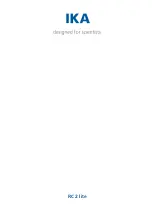
8
9
/// Disposal instructions
› The device, accessories and packaging must be disposed of in accordance with local and
national regulations�
/// Maintenance
› The device must only be opened by trained specialists, even during repair� The device must
be unplugged from the power supply before opening� Live parts inside the device may still
be live for some time after unplugging from the power supply�
/// Power supply / switching off the device
› The voltage stated on the type plate must correspond to the power voltage�
› The device can only be disconnected from the power supply by pulling out the power plug
or the connector plug�
› The device must only be operated with the original power cord set�
› The socket for the power cord must be easily accessible�
› Socket must be earthed (protective ground contact)�
› After a power failure during operation, the device may start automatically (depending on
operating mode)�
› Disconnect the power plug before attaching or changing any accessories�
› Disconnect the power plug before cleaning, maintenance and transportation of the unit�
/// Fluid
Warning!
› Only use the fluids, which fulfill the requirements for safety, health and device compatibility�
Be aware of the chemical hazards that may be associated with the bath fluid used� Observe
all safety warning for the fluids�
› Depending on the bath fluid used and the type of operation or toxic can arise� Ensure suitable
extraction�
› Do not use any fluid which may cause dangerous reactions during processing�
!
Notice!
› Only use recommended bath fluid� Only use non-acid and non corroding fluid�
› Never operate the device without sufficient fluid! Check the fluid level detection at a regular
basis�
› Continuous monitoring of the filling level of the bath fluid is required�
› To ensure a sufficient fluid circulation, the viscosity of the bath fluid must not exceed of 50 mm2/s
at the lowest operating temperature�
› Untreated tap water is not recommended� It is recommended to use distilled water or high
purity water (ion exchangers) and add 0�1 g soda (sodium carbonate Na2CO3) /liter, to reduce
corrosive properties�
› Don’t use following fluids:
- Untreated tap water
- Acids or bases
- Solutions with halides: chlorides, fluorides, bromides, iodides or sulfur
- Bleach (Sodium Hypochlorite)
- Solution with chromates or chromium salts
- Glycerine
- Ferrous water�
/// Accessories
› Protect the device and accessories from bumping and impacting�
› Check the device and accessories beforehand for damage each time when you use them� Do
not use damaged components�
› Safe operation is only guaranteed with the accessories described in the ”Accessories” section�
!
Notice!
› Covers or parts that can be removed from the device without tools must later be refitted to
ensure safe operation� This will prevent the infiltration of foreign objects, liquids and other
contaminants�
› The feet of the device must be clean and undamaged�
› Always empty the bath if the unit is unused for long time�
› A laboratory circulator refrigerates and circulates fluid according to specified parameters� This
involves hazards due to high and low temperatures and general hazards due to the device
of electrical energy� The user safety can not be ensured simply with design requirements on
the part of the device� Further hazard sources may arise due to the type of tempering fluid,
e�g� by exceeding or undercutting certain temperature thresholds or by the breakage of the
container and reaction with the carrier fluid� It is not possible to consider all eventualities�
They remain largely subject to the judgment and responsibility of the operator� For this
reason, it become necessary for user to take other precautionary safety measures�
› The device may only be used as prescribed and as described in these operating instructions�
This includes operation by instructed specialist personnel�
› When device is used for external circulation, extra precaution must be taken for cold fluid
leakage due to damaged hose�
- Use suitable hoses for connection�
- Secure hoses and tubes against slippage and avoid kinks�
- Check hoses, tubes and bath at regular intervals for possible material fatigue (cracks/leaks)�
› Do not transport or empty the bath while it is still cold�
› Always empty the bath before moving the unit�
Summary of Contents for RC 2 lite
Page 1: ...RC 2 lite...
Page 2: ...3 ENGLISH...


















